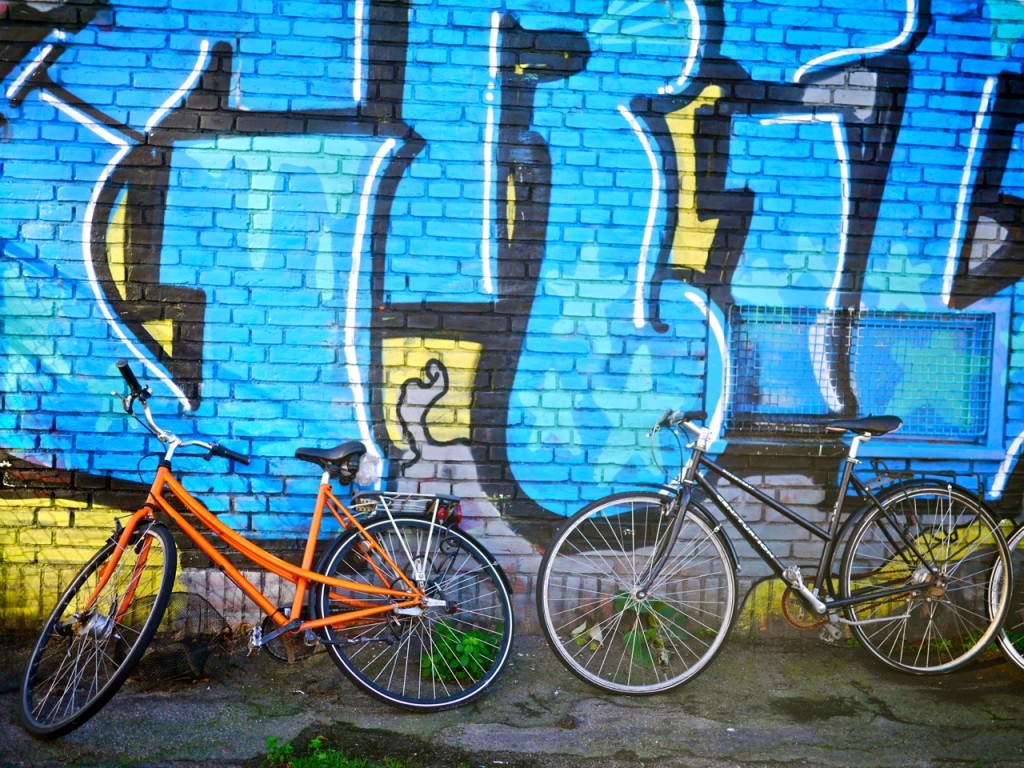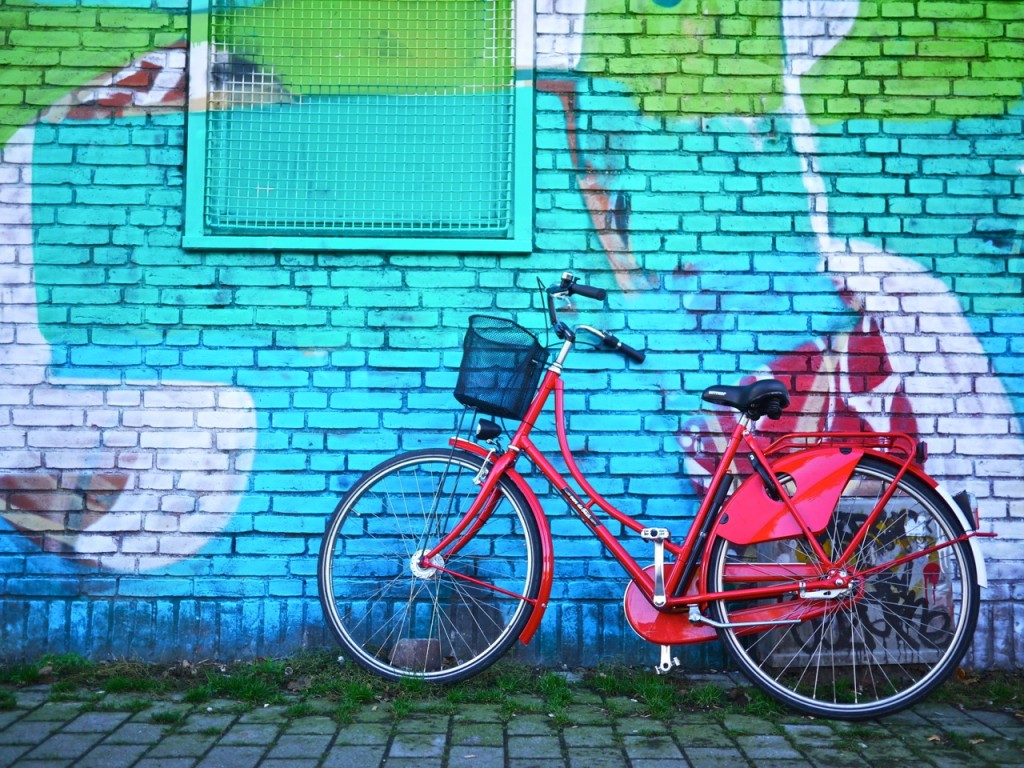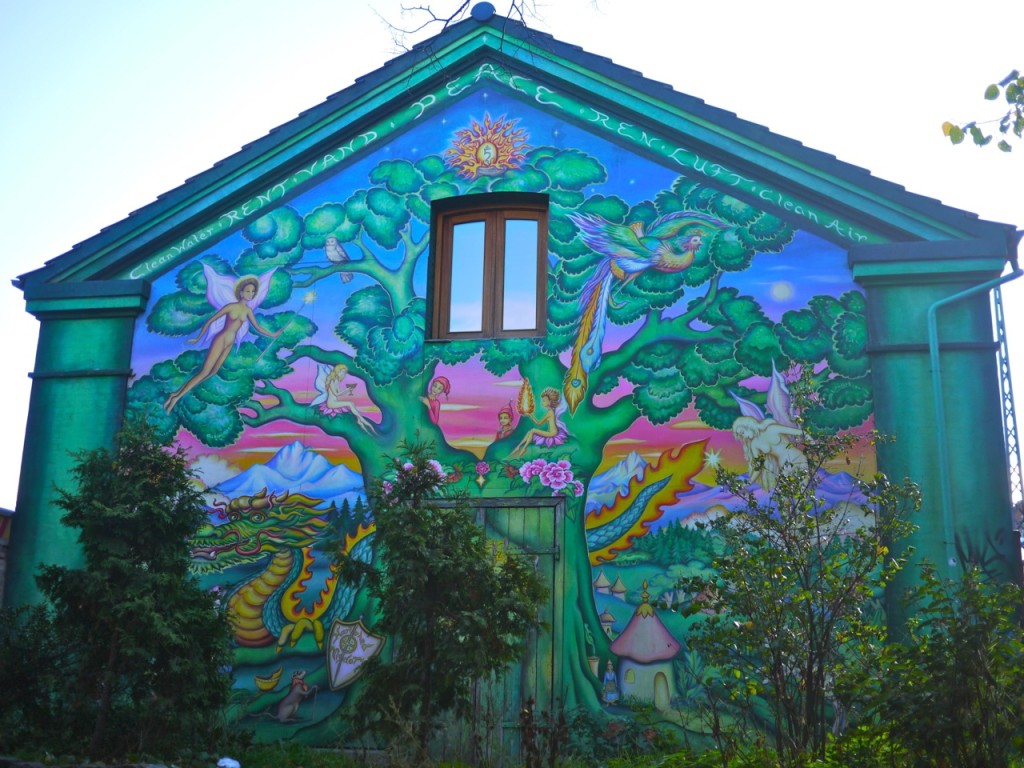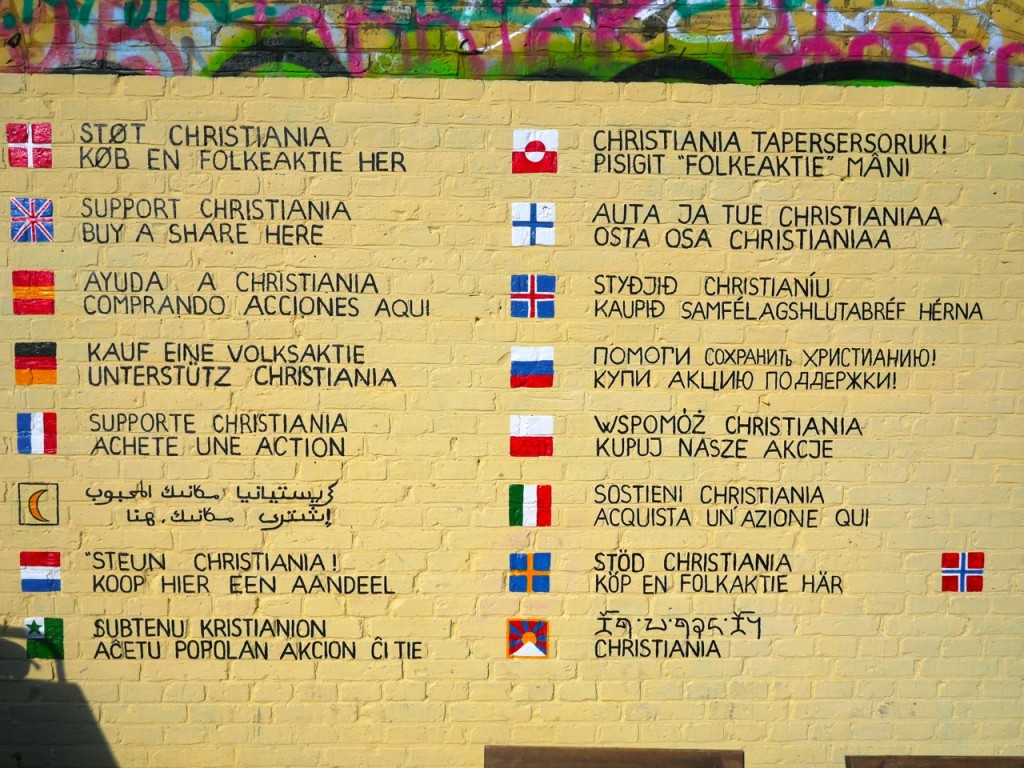“Christiania was fascinating,” I wrote in my pink notebook one evening when Jorge and I were relaxing in our room at Hotel Fox in Copenhagen. “but it seemed sad in a way, a bit past its time, like walking through the decaying remnants of what was once an incredible realisation of a dream. It seemed to be a community clinging to the past, attached to an ethos of fighting the system, like a living museum of the 1970s that tourists are itching to see.”
And I suppose we were just another set of those tourists really. We arrived shortly after spending half hour sitting in a nearby cafe in Christianshavn to warm our frozen toes on a bitter October afternoon, watching bikes roll by the windows.
I was drawn immediately to the entrance which was covered in street art.
We walked inside a small doorway to another world, or at least what is a self-proclaimed autonomous area. The other entrance says, “You Are Now Leaving the European Union.”
To put some background behind this, the story of Christiania started in 1971 when a group of squatters moved into what was an abandoned 18th century fort, a former military barracks called “Bådsmandsstræde”. It’s an area of 84 acres, full of nature which is respected by the community, an area with woods and canals as well as empty brick buildings.
The community who lives there values group consensus and private property ownership is frowned upon. Now, there are about 900 people living there, some of the third generation.

They have their own currency called the Løn, which is accepted by anyone in Christiania and worth around 50 Danish kroner (which is about USD$9 or £5.50).
They have their own red flag with three yellow circles to represent all of the “i”s in Christiania.
And they have a mission statement that starts like this:
“The objective of Christiania is to create a self-governing society whereby each and every individual holds themselves responsible over the wellbeing of the entire community. Our society is to be economically self-sustaining and, as such, our aspiration is to be steadfast in our conviction that psychological and physical destitution can be averted.”
We walked on past graffiti-covered walls and repurposed car parts turned into outdoor furniture. There were logs painted as snakes. We saw knitting wrapped around trees. There was a painted wall asking people to support Christiania in 16 different languages. It was, in some ways, a grittier, hippie-er version of London’s Eel Pie Island.
Until we smelled the hash, anyway. That’s the main draw for most tourists, the fascination of the main drag, Pusher Street. There’s about 40 or so shops in christiania where you can buy about 40 different types of hash and weed, many of the open 24 hours a day. Tables are laid out along the sides of the street with huge light and dark bricks of hash: Kashmir, Afghan, Red Moroccan and Butter Ice. There’s a huge variety of weed, of course, as well: White Widow, AK47, Dansk Super Pot, Lemon Haze and Amnesia.
The main street also sells some artisan crafts made by locals, but the stalls with the marijuana seem to demand more attention.
This area is called the “Green Light District”. There’s strictly no photography allowed here and it’s wise to obey the rules with stories not just of people being asked to delete photos but of phones being taken and nailed to a board to prove a point. So the camera disappeared as we entered the zone (the photos in the rest of this post are also from around the entrance area).
As a reminder, there are signs and graffiti images of crossed out cameras everywhere. There are two other rules as well. One is not to run, which is also smart to obey considering the size and strength of quite a few not so friendly looking unleashed dogs lounging in the sun. The other rule is simply to have fun.
I did find a handful of photos from inside the no photo zone, from a photographer called Martin Lehmann, that show the merchandise on display.
It’s interesting to note that while the community is all for the legalization of pot, they have successfully banned all chemical drugs from the area.

There was an mix of hippies, skinheads and tourists inside the “Green Light District”. Like the rest of the area, it is car free. It’s a colourful place. There’s reggae music and electronic music. And everywhere you look people are rolling joints.
You can find pretty much everything you need in Christiania. It’s pretty self contained. They sell fresh food and organic home-made beer. There’s entertainment beyond getting high, like a skatepark, pubs, cafes, a museum about the area, a cinema, recording studio and galleries.

Art is really important here. In fact, it wasn’t so long ago that the Danish Cultural Institute held an exhibition called Christiania in Art to highlight some of the talent, showing the work of 28 local artists with more than 300 paintings, photographs, ceramics and sculptures on display. Also part of the exhibition was this brilliant series of photographs of Christianites (and short bios) by Danish photographer Charlotte Østervang.

Other types of creativity come into play in everyday life as well. Architecture is one example. People build their own homes here, of just about anything they can find. There’s a building supply shop, but there’s plenty of improvisation. One house is built out of windows and their frames. And there’s loads of quirky lawn decor to match.

Christiania is one of the biggest and the longest standing communes in the world. Times have changed a lot though, as the residents have been paying taxes for about a decade now to cover costs of basics like water and electricity. A few years ago they ended up in an agreement with the government to buy parts of the land, which they did collectively.

It’s been controversial from the beginning, but mainly for the drugs which are still illegal. There’s police raids, but they do take it pretty easy.
And just beyond the exit, which says, “You are now entering the EU”, it’s like walking back into the present, they smell of marijuana fading into the distance.

Reading about Christiania and seeing videos of the people inside their homes, speaking about the community has been more interesting than strolling through the Green Light District. There’s a Kickstarter project set up to fund a documentary on Christiania, the filming of which started in 2006. It was funded and should be ready any day now. There’s a trailer on Vimeo and I’m looking forward to watching it. In the meantime, here’s a little tour inside one of the tiny houses, a 20-minute Belgian documentary and a little video called “Christiana With Love“. Vanity Fair has an article worth a read as well.













4 Comments
Mandy
January 27, 2014 at 7:11 pmWow, that’s pretty fascinating! I never had any idea that communes like this existed today, especially not in Copenhagen (although my mind is screaming Cult! Cult!)
littleobservationist
January 27, 2014 at 7:55 pmYes, it was a very interesting place to see. It’s definitely a world of its own!
sezanpull@yahoo.com
October 12, 2014 at 3:55 amIncredible, that’s very amazing! My partner and i in no way acquired almost any idea that communes in this way been with us right now, especially definitely not within Copenhagen (although my personal intellect is badly behaved Cult!
Adam
June 1, 2015 at 6:58 pmI’m so excited to visit!